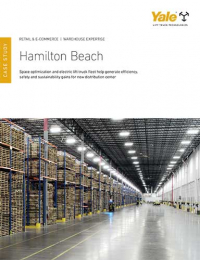Moore on Pricing: How shippers can help ease the driver shortage
Latest Material Handling News
In a recent article by Cornelius Frolik in the Dayton Daily News, we learned that the number of licensed truck drivers in the State of Ohio dropped for the first time on record.
Frolik sited several factors including the aging work force and relatively low wage—averaging around $38,000 per year—as contributing to the perceived lack of new entrants. He also notes that new trainees graduating driver schools are averaging 54 years of age, indicating that driving is a possible second career or fallback position when better-paying jobs are scarce.
And while truck driving is the third fastest growing job category according to the U.S. Labor Department, the pay is well below the first and second in growth, which are registered nurses and post-secondary educators. And, of course, driver turnover rates remain extraordinarily high.
In fact, the Owner Operators and Independent Drivers Association (OOIDA) recently noted that some 40,000 new commercial driver licenses are granted by DOT annually, but their estimate is that turnover is over 100+ percent per year due to poor working conditions. Not mentioned by OOIDA is the increasing difficulty in compliance with safety regulations and initiatives like CSA. With these factors in mind, the American Trucking Associations (ATA) has estimated that there will be a shortage of over 240,000 drivers in the coming decade.
This is much more than an internal industry problem, and we’re all going to see higher rates, greater risk, as well as an impact on performance metrics when there’s a shortage of qualified operators.
What can shippers do to help the industry and themselves to increase the ranks of qualified drivers? Well, when you step back and give it some thought, quite a bit.
Three often-mentioned negatives to being a truck driver are working conditions, wasted time running empty, and the resulting limits on personal income from the previously named factors. Drivers and their company make money hauling loaded trailers—down time is dead time.
I remember a visit to a client’s distribution center where I saw a 10-foot painted circle on the floor near the loading docks. It was explained to me that this is where the drivers were told to stand while being loaded. There was no restroom or even a cell phone signal.
During this visit, I also learned that they were having trouble getting loads covered despite being located just off Interstate 95 in Maryland. In talking to drivers, I learned that the word was out that this is the last place from which you agree to take a load. If this sounds a bit like your warehouse then let me offer you some free advice: Fix it.
Shippers need to be advocates for drivers. You should be looking to see that your carriers and fleet operators are treating drivers with respect and paying a fair wage. You should also meet with your carriers and talk about how your loads fit into a regional network.
Should you be using dropped trailers or live loading? Which receiving and loading operations practices are causing down time for drivers? Can you provide backhauls by sharing inbound/outbound-matching opportunities?
In the public discussions on infrastructure, shippers’ voices are rarely heard. The carriers are speaking up for safe truckers rest stops, faster toll collection, and use of tandem trailers. If major shippers and local businesses add their voices to such improvements politicians would pay more attention.
With pressures on hours of service labor capacity, limits on immigration, and an average new driver age of 54, shippers need to proactively promote careers in transportation—and treat operators as professionals who have a choice as to whom they provide service.

Article Topics
Columns News & Resources
Latest in Materials Handling
Lucas Watson appointed CSO for Körber’s Parcel Logistics business in North America Hyster recognizes Dealers of Distinction for 2023 Carolina Handling names Joe Perkins as COO C-suite Interview with Keith Moore, CEO, AutoScheduler.AI: MODEX was a meeting place for innovation Walmart deploying autonomous lift trucks at four of its high-tech DCs Coles shops big for automation Kathleen Phelps to join FORTNA as chief financial officer More Materials HandlingSubscribe to Materials Handling Magazine

Find out what the world's most innovative companies are doing to improve productivity in their plants and distribution centers.
Start your FREE subscription today.
April 2024 Modern Materials Handling

Latest Resources










